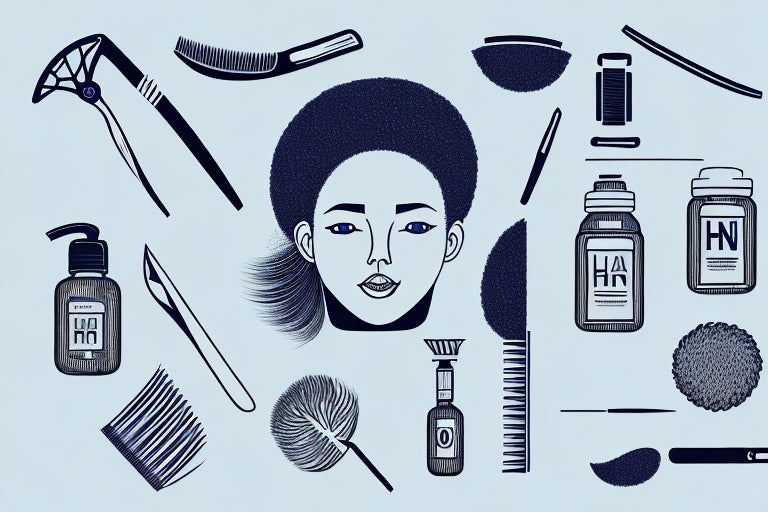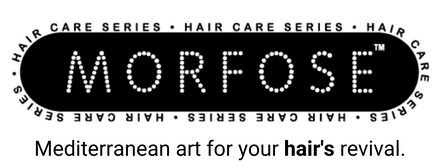Exploring Low-Poo and No-Poo Methods for Healthy Hair
Posted by MORFOSE COSMETICS

Exploring Low-Poo and No-Poo Methods for Healthy Hair
Keeping your hair clean and healthy is an essential part of taking care of yourself. However, traditional shampooing and hair care methods may not be the best solutions for all hair types, especially those prone to dryness and brittleness. Many people have turned to low-poo and no-poo methods of cleansing their hair, which are becoming increasingly popular due to numerous benefits. In this article, we will explore these methods and the science behind them, the advantages, and some popular techniques for trying them out.
Understanding Low-Poo and No-Poo Hair Care
Before diving into the benefits and techniques of low-poo and no-poo hair care, let's first understand what these terms mean. Traditional shampoos usually contain chemicals that can strip hair of natural oils, which may cause dryness, breakage, and even hair loss. In contrast, low-poo and no-poo methods involve reducing or eliminating the use of traditional shampoos, and cleaning hair with alternative products that are gentler and more natural.
The Science Behind Traditional Shampoos
Traditional shampoos contain ingredients such as sulfates, which create the lathering effect and help remove dirt and oil from the hair. However, sulfates can be harsh and strip hair of necessary moisture, which may cause the scalp to produce more oil to compensate. This cycle can lead to greasy hair and scalp irritation. Additionally, other ingredients such as parabens and silicones may accumulate on the hair and scalp, creating a buildup that may lead to dullness and breakage.
What are Low-Poo and No-Poo Methods?
Low-poo involves using shampoos that have fewer harsh chemicals and sulfates, while no-poo means using alternative products to clean hair, such as natural clays, conditioners, or even just water. The goal of both methods is to reduce the stripping of natural oils from the hair and scalp, leading to healthier, more manageable hair.
Low-poo and no-poo methods have gained popularity in recent years due to their many benefits. For example, these methods can help reduce frizz, increase shine, and improve the overall health of the hair and scalp. They are also more environmentally friendly, as they often use natural and biodegradable ingredients.
One popular low-poo method is co-washing, which involves using a conditioner to cleanse the hair instead of shampoo. This method can be especially beneficial for those with curly or dry hair, as it helps retain moisture and prevent breakage.
No-poo methods, on the other hand, may involve using natural clays such as bentonite or rhassoul clay to cleanse the hair. These clays are rich in minerals and have been used for centuries to cleanse and nourish hair and skin. Another no-poo method is the water-only method, which involves using just water to cleanse the hair. This method can be challenging at first, as it may take time for the scalp to adjust to producing less oil.
Overall, low-poo and no-poo methods can be a great way to improve the health of your hair and scalp, while also being kinder to the environment. Experiment with different methods and products to find what works best for your hair type and lifestyle.
Benefits of Low-Poo and No-Poo Methods
Healthier Hair and Scalp
Low-poo and no-poo methods have been gaining popularity in recent years due to their potential to promote healthier hair and scalp. By using gentler ingredients and reducing the frequency of washing, these methods can help maintain a healthy balance of natural oils on the scalp and hair.
Many traditional shampoos contain harsh chemicals that can strip the hair and scalp of its natural oils, leading to dryness, breakage, and other issues. In contrast, low-poo and no-poo methods use natural and organic ingredients that are gentler on the hair and scalp.
This can lead to stronger, thicker, and more lustrous hair. Additionally, it may reduce scalp irritation and dandruff caused by harsh chemicals.
Reduced Environmental Impact
Another benefit of low-poo and no-poo methods is their reduced environmental impact. Traditional hair care products can contain harmful chemicals that may enter the water system and affect aquatic life.
By using natural, biodegradable ingredients, low-poo and no-poo methods can reduce environmental damage and promote sustainability. This is especially important in today's world, where more and more people are becoming aware of the impact of their daily actions on the environment.
Cost Savings and Simplified Hair Care Routine
Many traditional hair care products can be expensive and require various products to achieve a desired look. With low-poo and no-poo methods, fewer products are needed, which can save time and money.
Additionally, these methods may require less styling and fewer hair products, which can further simplify the hair care routine. This is especially beneficial for those who lead busy lives and don't have the time or energy to spend hours styling their hair.
In conclusion, low-poo and no-poo methods offer numerous benefits for those looking to maintain healthier hair and scalp, reduce their environmental impact, and simplify their hair care routine. By using natural and organic ingredients and reducing the frequency of washing, these methods can help promote stronger, more lustrous hair, while also benefiting the planet.
Popular Low-Poo and No-Poo Techniques
Are you tired of using harsh shampoos that strip your hair of its natural oils? Do you want to embrace a more natural approach to hair care? If so, you may be interested in trying out some low-poo or no-poo techniques.
Co-Washing (Conditioner Only Washing)
Co-washing is a technique where hair is cleansed using only conditioner instead of traditional shampoo. Conditioners contain some cleansing agents that can remove dirt and buildup while conditioning the hair. This method is especially useful for curly or thick hair, which may benefit from additional moisture, and can improve the hair's natural texture and definition.
When co-washing, it's important to choose a conditioner that is free from silicones and other heavy ingredients that can weigh down the hair. You may also want to consider using a clarifying shampoo occasionally to remove any buildup that may accumulate over time.
Water-Only Washing
Water-only washing involves washing hair only with water and avoiding any hair products. This method may be suitable for those with naturally oily hair, as water alone can effectively remove dirt and grease. Over time, the scalp may adjust to produce less oil, leading to shiny, manageable hair.
However, it's important to note that water-only washing may not be suitable for everyone. Those with dry or damaged hair may find that their hair becomes even drier and more brittle with this method. Additionally, if you live in an area with hard water, the minerals in the water may build up on your hair and scalp, leading to dryness and irritation.
Baking Soda and Apple Cider Vinegar Rinse
This method involves using a baking soda and water mixture to remove impurities from the hair, followed by an apple cider vinegar rinse to restore the hair's natural pH. This method can help remove buildup without damaging the hair, and the rinse may leave the hair shiny and voluminous.
However, it's important to use caution when using baking soda on your hair. Baking soda is highly alkaline and can be harsh on the hair and scalp if used too frequently or in high concentrations. Additionally, some people may find that the apple cider vinegar rinse is too acidic for their hair, leading to dryness and irritation.
Natural and Organic Shampoo Alternatives
If you're not quite ready to give up shampoo altogether, you may want to consider using a natural or organic shampoo alternative. Many brands now offer shampoo alternatives that contain natural, organic, or plant-based ingredients. These products can be used similar to traditional shampoo but are gentler on the hair and scalp.
Some examples include shampoo bars, which are a waste-free alternative and can last longer than liquid shampoo, or clay-based shampoos, which can absorb excess oil while maintaining moisture and shine. It's important to read the ingredients list carefully and choose a product that is free from sulfates, parabens, and other harsh chemicals.
By embracing a low-poo or no-poo hair care routine, you can help keep your hair healthy, shiny, and full of life. Experiment with different techniques and products to find what works best for your unique hair type and needs.
Transitioning to Low-Poo or No-Poo Hair Care
Managing Expectations and Initial Challenges
Transitioning to low-poo or no-poo hair care can be a challenging process, and it may take time for the hair and scalp to adjust. Initially, hair may feel greasy or weighed down, but this is normal and should improve over time. It is important to be patient and manage expectations for the desired outcome.
When transitioning to low-poo or no-poo hair care, it is important to understand that traditional shampoos contain harsh chemicals that strip the hair of its natural oils. This can cause the scalp to overproduce oil, leading to greasy hair. By switching to a low-poo or no-poo routine, you allow your scalp to regulate its oil production naturally, resulting in healthier hair in the long run.
It is also important to note that the transition period can vary from person to person. Some may experience a few weeks of greasy hair, while others may take several months to fully adjust. However, with patience and perseverance, the end result is worth it.
Tips for a Smooth Transition
To make the transition process easier, consider gradually reducing the frequency of traditional shampooing, and incorporating gentle alternatives such as co-washing or natural shampoos. Co-washing involves using a conditioner to cleanse the hair, while natural shampoos are free of harsh chemicals and sulfates. These alternatives can help ease the transition period and allow your hair to adjust more gradually.
Another helpful tip is to use a natural bristle brush to distribute oils evenly throughout the hair and scalp. This can help prevent buildup and promote healthy hair growth. Additionally, using a scalp exfoliating treatment can help remove buildup and dead skin cells, allowing for better absorption of hair care products.
Customizing Your Low-Poo or No-Poo Routine
Everyone's hair is different, and finding the right low-poo or no-poo routine may require some trial and error. Experiment with different methods and products, and pay attention to how your hair and scalp respond. Some people may find that they need to wash their hair more frequently than others, while some may need to use a clarifying treatment occasionally to remove buildup.
It is also important to consider your lifestyle when customizing your low-poo or no-poo routine. For example, if you exercise frequently or live in a highly polluted area, you may need to wash your hair more often. Similarly, if you have color-treated hair, you may need to use specific products to maintain your color.
Overall, transitioning to low-poo or no-poo hair care can be a rewarding journey towards healthier, more vibrant hair. With patience, perseverance, and a willingness to experiment, you can find a routine that works for you and your individual hair needs.
Conclusion
Switching to low-poo or no-poo hair care methods may seem daunting at first, but the benefits are numerous. Healthier hair and scalp, reduced environmental impact, and simplified hair care routines are just a few of the advantages. With a variety of methods and products to choose from, it is possible to find the right low-poo or no-poo routine that works for your hair type and lifestyle. Give it a try, and see the difference that gentle, natural hair care can make for your hair and scalp.


